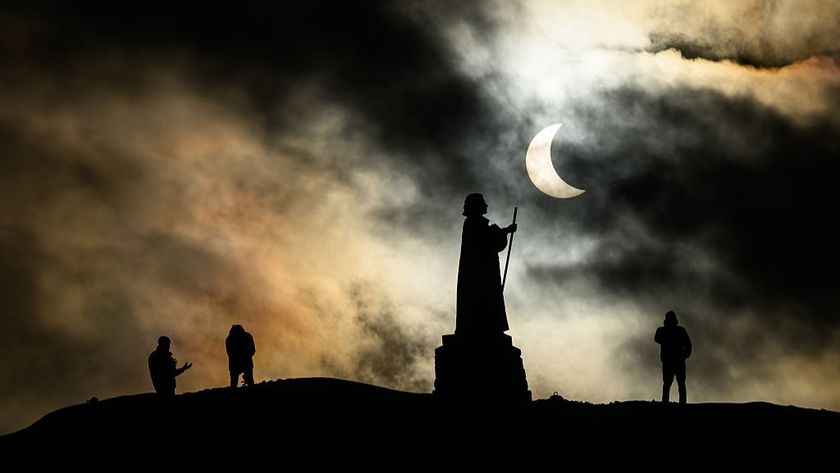SpaceX Shows Off Manned Dragon Capsule at Space Expo

LOS ANGELES — As private spaceflight company SpaceX puts the finishing touches on the interior of its prototype crewed capsule, the firm brought a life-size model of the vehicle to display here at the first annual Spacecraft Technology Expo.
The design of SpaceX's Dragon capsule recently passed a series of key reviews, during which a group of NASA engineers and former space shuttle astronauts tested how well they could maneuver inside the spacecraft. The NASA team practiced entering and exiting Dragon under normal and emergency scenarios, and they also evaluated the layout of the vehicle's controls and instruments.
"This milestone demonstrated the layout of the crew cabin supports critical tasks," SpaceX Commercial Crew Development Manager Garrett Reisman said in a statement. "It also demonstrated the Dragon interior has been designed to maximize the ability of the seven-member crew to do their job as effectively as possible."
SpaceX let attendees of the expo — which runs from May 8-10 at the Los Angeles Convention Center — see what the NASA evaluators saw. The company displayed the test version of Dragon at a special exhibit called the "Human Spaceflight Park," which includes full-size and scaled models of various other rockets and spacecraft, including XCOR Aerospace's suborbital Lynx space plane.
Unmanned Dragon set to fly
SpaceX is preparing to launch an unmanned version of the Dragon capsule to the International Space Station on May 19. The spacecraft will ride into orbit atop the company's own Falcon 9 rocket from the Cape Canaveral Air Force Station in Florida.
The test flight is designed to assess the spacecraft's ability to carry cargo to the orbiting outpost. If successful, the mission will mark the first time that a privately built spacecraft has docked with the space station. [Gallery: Dragon, SpaceX's Private Spacecraft]
Get the Space.com Newsletter
Breaking space news, the latest updates on rocket launches, skywatching events and more!
But SpaceX has ambitions beyond ferrying cargo and supplies to the orbiting complex. The company is aiming to use Dragon as the basis for a crewed capsule to take astronauts to the space station, and one day on to Mars.
"From the beginning, we intended it to carry people," Reisman said Tuesday (May 8) in a panel discussion about commercial human spaceflight.
Reisman is a former NASA astronaut who flew twice on the space shuttle and spent roughly three months living at the International Space Station. He left the agency in 2011 to join SpaceX, after the company successfully launched and returned the Dragon capsule from orbit, becoming the first commercial company to accomplish the feat in December 2010.
"I saw that the game was changing," Reisman said. "Something really remarkable was happening. We were entering a new golden age, and I was very excited about what I saw."
Hawthorne, Calif.-based SpaceX has submitted a proposal for the third and final funded phase of NASA's commercial crew program, which requires companies to present a complete launch system — a rocket and vehicle — for consideration.

Seven-astronaut crew
In the crewed version, the Dragon capsule is designed to fit seven passengers. The full-size mockup on display here was used to test the vehicle's design and cabin layout.
"We're looking forward to proceeding in the next phase, and hopefully in the next several years, we'll have people flying on Dragon," Reisman said.
But for now, all eyes are on the unmanned Dragon, which is currently sitting atop a Falcon 9 rocket on its Florida launch pad. After being delayed several times, the Dragon capsule's test flight to the space station is slated to occur in just 10 days.
"Stay tuned," Reisman said. "I'm feeling pretty good about this one."
You can follow SPACE.com staff writer Denise Chow on Twitter @denisechow. Follow SPACE.com for the latest in space science and exploration news on Twitter @Spacedotcom and on Facebook.
Join our Space Forums to keep talking space on the latest missions, night sky and more! And if you have a news tip, correction or comment, let us know at: community@space.com.

Denise Chow is a former Space.com staff writer who then worked as assistant managing editor at Live Science before moving to NBC News as a science reporter, where she focuses on general science and climate change. She spent two years with Space.com, writing about rocket launches and covering NASA's final three space shuttle missions, before joining the Live Science team in 2013. A Canadian transplant, Denise has a bachelor's degree from the University of Toronto, and a master's degree in journalism from New York University. At NBC News, Denise covers general science and climate change.









